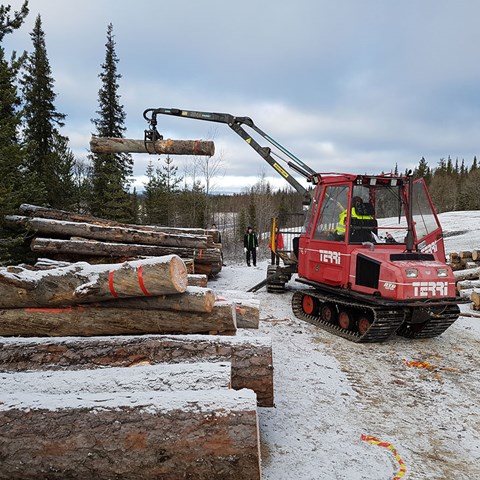Contact
Department of Wildlife, Fish and Environmental Studies

Restoration of degraded habitats is often used as a way to compensate for the exploitation of areas of significant natural value. However, it takes a long time for nature to create many of the structures that are a prerequisite for biodiversity; like large old trees and deadwood. Now a new method is being tested in northern Sweden where hundreds of dead trees have been moved from an area that was exploited. Initial results show that the method can be a cost-effective way to speed up the regeneration of areas with high biodiversity, but that the method should be developed to include dead trees of more species and in later stages of decay.
Forestry, mining and energy production affect nature and lead to loss of biodiversity. When the Aitik mine in northern Sweden was to expand in 2017, an oldgrowth forest with high natural values was felled. To meet the legal requirements for ecological compensation, 640 dead trees were moved to a compensation area.
“Society today faces the challenge of balancing economic development and the transition to a fossil-free society with the preservation of biological diversity. To make this possible, the concept of ecological compensation has been developed, which requires those who damage natural values to compensate by protecting or improving natural values in another place. In this project, we have the opportunity to evaluate to what extent this method of moving deadwood actually compensates the natural values”, says Therese Löfroth, researcher at the Swedish University of Agriculture, SLU.
In connection with the tree removal, a research project was started to monitor how the insects, fungi, mosses and lichens that live in the deadwood in the felled forest cope with the move and whether they can continue to live in the new area. The first step is to assess whether the relocation has provided an improved habitat in the compensation area
The first results show that the amount of deadwood in parts of the compensation area is equivalent to the harvested area, but that the composition differs.
“Deadwood from willow and deadwood in later decay stages were not moved and are therefore missing from the compensation area. This points to a need for future compensation projects to include more types of dead wood in order to better minimize the loss of ecological values.”, says Olov Tranberg.
The researchers have calculated the cost of the relocation, where the final sum landed at approximately SEK 300,000 for the relocation of the 640 tree trunks.
“On a smaller scale it is possible to compensate for a loss of dead wood at a relatively low cost. But in order to fully compensate for the loss of dead wood at landscape level more comprehensive efforts are needed, which entail significantly greater costs. These costs are still relatively small when compared to the large investments that many industrial projects involve.”, says Therese Löfroth.
Removal of dead wood can thus accelerate the regeneration of important natural values, but the method needs to be refined to ensure that the ecological benefit is maximized.
“The next step will be to follow up on how the species survive in the new location. We will evaluate how woodl-living beetles, mosses and lichens thrive in their new environment.”, says Olov Tranberg.
Tranberg O., Hekkala A-M, Lindroos O, Löfroth T, Jönsson M, Sjögren J, Hjältén, J. Translocation of deadwood in ecological compensation, a novel way to compensate for habitat loss. Ambio (2023). https://doi.org/10.1007/s13280-023-01934-0
Olov Tranberg
(Click for high-resolution image.)
Therese Löfroth
(Click for high-resolution image.)